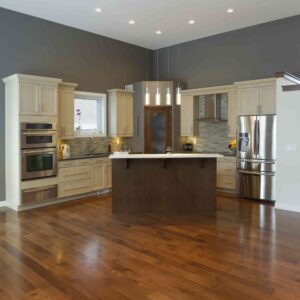Several years ago, the big trend in hardwood was the wider the better. It looked gorgeous. But it didn’t take long for manufacturers to stop making it and installers to stop selling it. Why? Because solid hardwood flooring is very sensitive to environmental factors. Keep the house too warm, the humidity levels rise and the hardwood’s edges curl up. Keep the house too dry and boards split. In order for solid wood to “stay put,” the conditions of a house must be kept perfect at all times otherwise there is a chance for the wood to react.
This is the primary reason most builders went from using wood 2×10’s and 2×12’s for framing and plywood on the subfloors to engineered wood materials. Solid wood expands and contracts when the environment changes (change of seasons). So when the weather would get really cold the wood would contract. In the summer, the humidity would cause the wood to expand. This is, obviously, not good when you’re trying to control floor squeaks.
The Joys of Engineered Hardwood Flooring
Changing over to engineered framing and sheathing, which most people did, reduces service calls for floor squeaks instantly. They virtually never squeak or cause any other kinds of service issues. This is because engineered material for hardwood flooring isn’t bothered by environmental factors.
So, why are we talking about engineered hardwood all of the sudden? Mostly because of Pinterest and Houzz and the adorable twins on HGTV. Everywhere you look, you see the wider plank hardwood flooring. But you can’t easily get it in solid hardwood. And if you can, the affordability factor goes out the door.
Comparing Engineered Hardwood Flooring to Solid Hardwood Flooring
While both engineered hardwood and solid hardwood flooring are made from real wood, the real difference is the way they are constructed. Solid hardwood is made from a single piece of wood and then covered with a layer of protective coating. Engineered hardwood is made from an engineered core (usually plywood), multiple layers of wood (under extreme heat & pressure) and then a protective coating. That’s not too much of a difference when you think about it, but when you say engineered, people immediately think “fake,” even though the top layers of each plank are made from real wood and engineered in a way that makes it better in so many ways. The bottom line is, there’s really no such thing as “wrong” in this decision. Both have their advantages and disadvantages, and both are fine additions to your home.
Get In Touch With Fisher Hardware And Lumber Today
Since 1894, Fisher Lumber and Hardware has been serving homeowners and professional contractors in the Maryland, Washington D.C., and Northern Virginia areas with top quality lumber, building materials, tools, and accessories. Operating under the same ownership since 1947, our business has been built on our reputation with our customers. Get in touch with us today by calling 301-424-6500 or by visiting our website. Stay in touch via Facebook,Pinterest, Twitter, and Google+ too!

